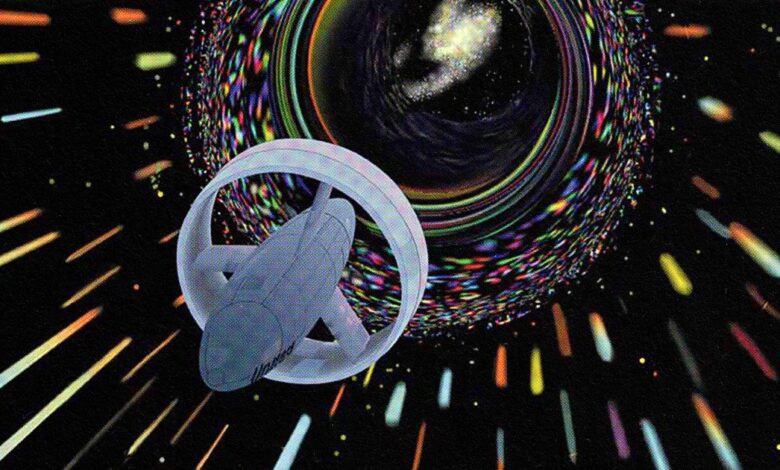Is Star Trek’s warp drive possible?

Central to science fiction, and Star Trek in particular, is the ability to travel the galaxy at speeds far faster than light via a fictional technology called a “warp drive.” What is that, and will we ever have one?
No warp drive for you
A provisional answer is “no.” According to the accepted laws of science, nothing can travel faster than light. Even though light is fast enough to circle the Earth over seven times in a single second, space is very large. It takes eight minutes for light to travel from the Sun to the Earth, and it would take four years for light from our Sun to reach the nearest star (Proxima Centauri). Most stars — and hence, most planets — are much more distant, so travel time would be correspondingly longer. The distances are so vast that interstellar travel would take lifetimes.
That makes for a boring sci-fi plot, so the creators of Star Trek invented a convenient, but imaginary, technology. According to Star Trek canon, the warp drive works by creating a “warp bubble” around the spaceship, inside of which space is literally warped. In front of the spaceship, space is compressed, while behind the vessel, it is expanded. In this way, a spaceship never travels faster than light; it merely passes through a shorter distance. For example, if a warp drive could shrink the distance to Proxima Centauri by 1/1,461 times the normal length, it could travel there in a single day.
A massive problem
Is this realistic? Maybe. To begin with, our best modern understanding of space comes from Einstein’s theory of general relativity. In this theory, gravity is understood not as a force as we typically imagine it, but rather as a bending of space. So, if space can be bent or distorted in some way, then a warp drive could be within the realm of accepted science.
However, this is where things get tricky. Within the theory of relativity, the quantity that bends space is mass (or, equivalently, energy). In familiar and simple terms, the enormous mass of the Earth bends space in its vicinity. This distortion results in the phenomenon we know of as gravity.
While the bending of space by matter is a fact, it doesn’t help our warp drive very much. The bending of space near the surface of the Earth is relatively modest. After all, the distortion doesn’t appreciably shorten the distance between the Earth and the Sun, let alone the nearest star. Thus, for a warp drive to be a useful propulsion technology, a spaceship might have to carry with it a mass much larger than a planet — or even larger than a star. This extra mass would make the craft too difficult to move, meaning that the idea just isn’t tenable.
Negativity about negative energy
Does this completely invalidate the idea of a warp drive? Not quite. The equations governing special relativity are rich and complex and there are many solutions. In 1994, theoretical physicist Miguel Alcubierre found a solution that distorted space in a way very similar to that originally envisioned by the creators of Star Trek. Under exactly the right conditions, it is possible to expand space behind an object and compress it in front.
There is a problem, though. To accomplish this distortion, researchers would have to use negative energy — that is, reduce the energy of empty space to below zero. According to Einstein, a warp drive requires an impossible premise. As an analogy, it’s possible that some mathematical calculation involving a person’s height might have a solution that is negative. But what would it mean for a person to have a negative height? It doesn’t make physical sense.
Therefore, while scientists try to find loopholes in the conditions required for Alcubierre’s solution, most think that a warp drive will not be created this way; negative energy is a mathematical artifact and not a physical phenomenon.
Is a warp drive possible or not?
Altogether, our current understanding of the laws of nature neither allows for faster-than-light travel nor an Alcubierre-like solution to warping space. However, those who dream of traveling the stars should not give up. Scientists do not have a full understanding of the laws of nature. Indeed, my colleagues and I spend our days looking for new phenomena — things that have never been seen before.
In speculative science, it is always foolhardy to say that something is impossible. In 1850, if you asked the best scientists of the day if it would be possible to speak in Europe and have someone in America hear you, or if it would be possible to look inside a person’s body, they would have told you “no.” Yet a scant half century later, the invention of radio and discovery of X-rays would have proved them wrong.
That is what it will take for a warp drive to be a reality. Some bright soul is going to have a new idea, something quite different from our current understanding of physics. Then, maybe — just maybe — we will be able to boldly go where no one has gone before.




